Memoir - Bruce M. Foxman
Memoir | Publications | Curriculum Vitae | Videos | Slides | Articles | Obituary
ACA Living History
2020

Chasing the Mysteries of Topotaxy, Solid-State Synthesis and Crystal Twinning:
Just as Much Fun in 2020 as It Was > 50 Years Ago!
Introduction
Just a brief note before I begin my story: in my post-Ph. D. career, I decided to specialize in inorganic chemistry, crystallography (including novel approaches to teaching of the subject), solid-state reactivity, and development of computer programs that could help us understand least squares refinement and crystal twinning. Looking back, I can’t say that I remember worrying about spreading myself too thin…I was just too doggone interested in everything I was doing, and having (as Al Cotton said about his scientific life) More Fun Than Fun [1]! The following narrative skips back and forth a bit in time in order to develop story lines on one subject area before switching to another. The references and some dating will help to give the reader an idea about “when” I did “what”. I have added pictures of many (but not all) of the helpful, influential people in my scientific life.
In the beginning
My early years in Youngstown, Ohio, in the ‘40s and ‘50s a great, hardscrabble center of steel production, had snippets of science: birthday presents from my Dad (an amateur ornithologist, pickle manufacturer, and steel salesman): a copy of a serious book on astronomy: Sun, Moon and Stars [2], a giant quartz crystal, the proverbial Gilbert chemistry set, and a shortwave radio that introduced me to a later love, Australia; …and… likely most important of all, occasional visits from a great-uncle, Isadore Amdur, a Professor of Chemistry at MIT.
 Isadore Amdur Isadore Amdur
Uncle Izzy got his Ph.D. from Pitt in 1932, at the tender age of 22. The story goes that, at that time, he was the youngest Ph.D. in the country. (Amazingly, Izzy’s great-great grandfather, Yehuda Leib Amdursky, was the great-great-great-great-grandfather of highly-renowned Stanford Professor Dick Zare and myself!). The seeds Uncle Izzy planted during a couple of visits no doubt stimulated an interest in chemistry, along with a job in my teens making and delivering pickles with my Dad. I never would have guessed that the batches of sodium benzoate that I prepared as a preservative for pickles would be a precursor to a long, rewarding career in the study of the structures and solid-state reactivity of metal carboxylates! I decided to enter Youngstown University in 1960, and study chemistry. I had an excellent teacher, Professor W. H. McCoy, but Youngstown U did not meet my needs in other subjects, and I sought a higher-level institution. Young folks often make decisions for complex reasons. I wanted to live in Iowa, away from the smoky mill valleys of Ohio, and also had an interest in Bix Beiderbecke, a jazz trumpeter who died in 1931: I had hoped to do research in chemistry, become an academic, and contribute to books on Bix-history: all worked out well, but here we’ll tell the chemistry and crystallography tale only! Uncle Izzy was contacted, and asserted that Iowa State was the best Iowa-choice for chemistry in 1960, and so I chose ISU for the next three years of undergraduate work. During my sophomore year, young Asst. Prof. John Verkade asked me to join his group, taught me glassblowing and how to synthesize some exciting new phosphorus ligands [3].
 John Verkade John Verkade
I began a career in coordination chemistry, wondering what the structures of my new compounds might be. My junior and senior years at Iowa State were most fulfilling: John was an excellent mentor, who got me to join the ACS and Chemical Society (now RSC) in 1963.
 John Corbett John Corbett
John Corbett, later one of my ‘volunteer mentors’ (these are the folks whom we need to stand up and cheer for), taught inorganic chemistry, in a course which emphasized structural chemistry, including the elegant work of Iowa State crystallographer, Professor Bob Rundle. Regrettably, Bob passed away at only 47 in 1963, so any chance that I might have learned crystallography at ISU was lost. Corbett’s lectures were edge-of-the-seat-stuff: you wanted to be a university teacher, just like this master, after you heard his first few lectures. At Iowa State, I went to seminars by many famous scientists, but those by Al Cotton, Larry Dahl and Stan Piper stood out, and I applied to grad school at MIT, Wisconsin and Illinois. I loved the Midwest, but it seemed appropriate to try some new geography, along with a feeling that MIT was my destiny. I wrote to Al, and asked that he find a spot for me in his MIT lab in summer 1964, just to keep myself research-sharp before I enrolled in grad school in the fall. The answer was YES(!), and after a week at home in Ohio with the folks, I moved to Cambridge.
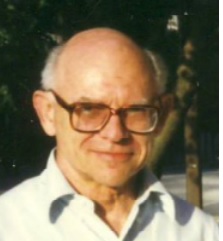 Al Cotton Al Cotton
On the first day at MIT I went to Professor Cotton’s office, and he asked me what I wanted to work on; I replied that I’d read some of his papers on lattice energy calculations, and that looked like pretty cool stuff! “Oh,” he said, “I’m not working on that anymore...I’d like you to learn crystallography, and get the crystal structure of ReI3.” That seemed a challenge in many ways, and indeed it was. First, all of the crystallography that the 1964 Cotton group knew and practiced was DIY: although MIT had a powerhouse of crystallographers: Bert Warren in physics, Martin Buerger in Earth Sciences, David and Clara Shoemaker in Chemistry, and Bernie Wuensch in Materials Science, the curriculum was such that there was little time for us to take any of the courses, though I learned a lot from many informal conversations with Bernie. Second, the tri-iodide of rhenium proved to be very easy to synthesize but was a very difficult crystal growth problem. I collected my first data set on Weissenberg films, quickly solved it by Patterson methods, but could not refine that structure below 30%, a puzzling result since the solution made chemical sense. A visitor to the lab in 1966, Leo Becka, was a brilliant young Argentine scientist who had done his Ph.D. with D. W. J. Cruickshank.
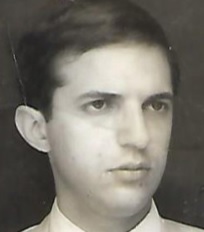 Leo Becka Leo Becka
Leo looked at my solution, and pointed out that it was very likely correct, since it fit perfectly into the putative unit cell. He looked over my data and pronounced it well, and suggested that I go through the refinement program, Charlie Prewitt’s SFLSQ-3, line by line, as there must be something wrong. That was a brilliant suggestion! I found a line in the FORTRAN code that rejected a reflection from the refinement if its ‘individual R value’ was > 33%. When I removed that line, my solution converged at 8%...a very exciting day! Leo showed me how to develop confidence in my own work, and how and when to apply critical thinking to programs and papers from other sources. My short time with Leo was a life-changing period. On a Friday evening near the time of Leo’s visit, I dressed up, and went to a dinner for Iowa State alums in Boston. At that dinner I met a pretty lass named Carole, who later became my companion for life. On that night, I returned to the lab in a very good mood, and set up experiments to grow better crystals of ReI3 . However, the reaction mixture needed to be heated, and it bumped, spraying (and ruining!) the suit I wore with a solution containing iodine. Thoroughly disgusted and discouraged, I put the ugly mess at the back of the hood, and months later was disposing of it when I noticed large gleaming crystals in the bottom of the flask [4]. This is an illustration of “Method 9” for crystal growth: Persistence – it always works! Those crystals were even better than the ones Leo helped me with, and the structure had a final R value of 4.4% [5]. Another special event occurred in October 1966: I joined the ACA!
Al Cotton was a superior mentor and educator, always approachable and ready to help. At the end of my first year, he hired Mike Bennett as a postdoctoral fellow in crystallography.
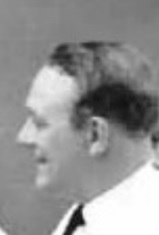 Mike Bennett Mike Bennett
Mike was a Ph.D. student of Sir Ronald Mason, and provided an excellent crystallographic pedigree through Dame Kathleen Lonsdale to Sir William Henry Bragg. It was Al’s expectation that Mike would teach the young folks about the subject, and straighten out the kinks in their (thus far) DIY education. To say that Mike far exceeded expectation is an understatement. He was an inspiring teacher, and taught us all aspects of crystallography extremely well. In addition, he and I wrote small and large programs for our lab, most notably SFLS5R (at MIT), a rigid body least-squares program, and SFLS5HR (later), which handled refinement of groups undergoing hindered rotation in the solid state [6]. The 1975 HR program had a built-in libration correction and superior modeling results compared to any other methodology available then or now. I have just learned from Richard Cooper that he and his student Natalie Haarer are currently putting our 1975 ideas into the Oxford CRYSTALS refinement program, really a dream come true! The Cotton group was a wonderful place to learn crystallography and inorganic chemistry. We had X-ray cameras, a GE XRD5 manual diffractometer and (later) a card-controlled GE XRD6 instrument; computing facilities included IBM 7094 and 360/65 computers. And, there were an amazing group of students, postdocs and visitors: Brian Johnson, Jon McCleverty, Dick Walton, Ken Caulton, Leo Becka, Guido Yagupsky, Alfredo Musco, John Bergman, Jack Wise, Tobin Marks, Steve Lippard, Dick Elder, Chuck Harris, Dave Weaver, Bruce Winquist, Roger Eiss, Joe Takats and Pete Legzdins, among others. My thesis, completed in 3.5 years, included four challenging structures. In my third year, I began to think about the next stage, and, along with career aims, decided that I would try to find something in Australia. Al was very supportive, and I landed a Research Fellow position (non-tenure track, 3-5 year appointment) at the newly-founded Research School of Chemistry (RSC) at the Australian National University (ANU) in Canberra.
Emigration and early career
Thus it came to pass that, as newlyweds in the Mike Bennett ACA Summer 2020 Structure Matters 22 Northern-Hemisphere Fall of 1968, Carole and I sailed to Australia on assisted-passage migrant visas! Australia had been the land of my dreams since childhood, and it truly had much to offer and impress. In 1967, the RSC was to have been founded by A. J. Birch, D. P. Craig, and R. S. Nyholm, three eminent Australian scientists in Organic, Physical and Inorganic chemistry, respectively. Sadly, Ron Nyholm, whose arrival was expected a bit later, died in a tragic auto accident in the UK, and his place was taken by the indomitable Alan Sargeson. In the 1960s, the RSC, ANU, and Australia were places where mateship, fairness, serious science, and both administrative and academic integrity – all coupled with humor and a unique twist on the English language – were valued to an extent I had not seen elsewhere (and would not see to that extent again). The Research Fellow positions at the ANU were unusual, best described as combining both postdoctoral and faculty qualities. We were expected to associate with one or more research groups, and could have small projects of our own as well. We were voting members of the faculty of the Research School of Chemistry, and our input was encouraged and always well-received. Most of my work was done in the group of Alan Sargeson [7], an especially creative, warm and friendly scientist, who was an excellent mentor, and added greatly to my chemical toolbox and critical thinking.
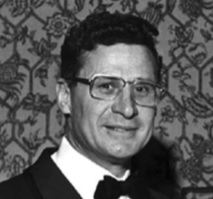 Alan Sargeson Alan Sargeson
Alan encouraged me to use my crystallographic skills to help us understand some of the work we were carrying out on solution kinetics and reaction mechanisms of cobalt(III) compounds. Most importantly, structural work on [Co(NH2CH3)5Cl][NO3]2 showed massive distortions that helped to explain the observed accelerations in the rate of base hydrolysis [8]. In order to carry out the structural work before our newly appointed crystallographer, Glen Robertson, arrived, I set up and checked out the newly-arrived Picker FACS-I diffractometer, which was controlled by a PDP-8 computer with paper tape I/O.
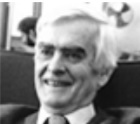 Glen Robertson Glen Robertson
Glen arrived at that time, and liked what I had done, but, always testing his mentees, asked that I derive the Lp correction for the Picker’s perpendicular monochromator geometry. With white knuckles, I got it right, and Glen and I became good mates after that. Glen always had a challenge to offer, with a new question every few days: “Where does the TDS (thermal diffuse scattering) from the acoustic modes peak in a diffraction experiment?” I cannot overstate how stimulating his questions were.
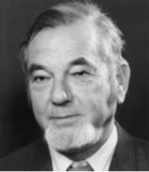 Arthur Birch Arthur Birch
One day, as I strolled through the hallways of the RSC, Professor Arthur Birch, the founding Dean of the RSC, stopped me to say hello. “Prof”, as we called him, had discovered the later-named “Birch reduction”, and was a synthetic organic chemist of world renown. “Bruce,” he said, “we really like having you here....but we do note that you don’t spend enough time in the library...you need to develop a plan for the next part of your career.” I was stunned. Here was the respected founding Dean, in a field far from my own, showing that he had his mind on the goings-on in the RSC, and cared greatly about mentoring young folks. That afternoon I indeed went to the library, and, discovering the journal Philosophical Transactions of the Royal Society for the first time, picked a volume at random, and it fell open to a paper by Dame Kathleen Lonsdale and J. F. Stephens containing oscillation and Weissenberg photographs of a single crystal undergoing a solid-state reaction [9]. I found the paper compelling, and decided that, if/when I had a position where I could study solid-state reactions of single crystals, that would be my focus. Thank you, “Prof”! My discussion with Prof also led to some nice modeling of radiation-induced decomposition; the FACS-I had only CuKα radiation available at that time, and the Co(III) complexes, highly absorbing, underwent significant decomposition during X-ray data collection. I was able to model the process well [10], based on work Mike Bennett had done at MIT [11]. That study promised success in my future endeavors.
As my appointment at RSC drew to a close, I began a search for a position back in the US. During the first season, I was unsuccessful, and then added a phrase to my letter that assured any interested parties that I could make the trip from the antipodes if I received partial support from 2 or 3 universities. That worked well: I landed a position at Brandeis University, and we left the Lucky Country in 1972 (I with a sense of loss) to return to Boston.
Back to the USA & a tenure-track career
The Chemistry Department at Brandeis had an NSF-Development grant that allowed me to arrange for the purchase of a Syntex P21 diffractometer, which was an excellent choice for a fellow with $66,000 in his pocket. Syntex flew me to Cupertino, CA to see the instrument, and I was impressed. My most significant memories from that visit were dinner and drinks with Bob Sparks and Sue Byram, who became two good friends I could always lean on.
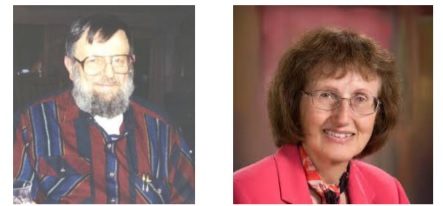
Bob Sparks Sue Byram
I recall asking Bob about the autoindexing program, and he pulled out an India ink pen, grabbed a stack of serviettes, and explained all. Somewhere in my files this stack still exists: I must find it! I also acquired Weissenberg, precession and powder cameras, and seemed well poised to reach high altitude. However, from the outset, getting my solid-state reactivity program off the ground at Brandeis was a challenge. In the 1970s, junior faculty in the department were not mentored or helped in any serious way, nor were they protected from onerous workloads. One wonderful colleague, organometallic chemist Mike Rosenblum, was a stellar exception to this, always willing to advise, discuss, and push forward.
 Mike Rosenblum Mike Rosenblum
We enjoyed a great collaboration over the years. Despite Mike’s help and my efforts, no students joined my group in the first three years, and I did most of the research work alone, late in the evening. As my spirits sank, I received an exciting invitation from Mike Foster at the IBM Thomas J. Watson Research Center to take a leave from Brandeis, and work on the reaction mechanism for the formation of the solid electrolyte referred to as “β-alumina”, formally a superionic conductor. Our growing family moved near Yorktown Heights, NY, with our one-month-old son Greg in summer 1975, and I embarked on that study. β-alumina is made by heating solid mixtures of Na2CO3 and α-Al2O3; Mike Foster had discovered that, if one substitutes θ-Al2O3 for the α-phase the solid-state conversion could be effected at a temperature 200 °C lower. This was a brilliant finding, and Mike hypothesized that it MUST be related to the structure of the theta phase. The θ-phase is only available as fine powder, but it is isomorphous with monoclinic Ga2O3 , which can be obtained as large single crystals. I proposed that we suspend single crystals of Ga2O3 in Na2O vapor in sealed iridium capsules at 1500 °C, and see what we could learn, an experiment which only a fantastic place like the Watson Center would be willing to fund! I was fortunate to work closely with Sam La Placa on this project.
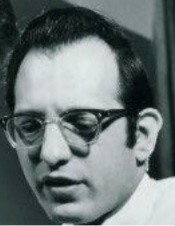 Sam La Placa Sam La Placa
Sam was an incredible colleague/scientist/mentor and friend. He had great love for science, respect for everyone, and created an atmosphere that was more fun than I’d ever had before working there; he was a truly remarkable, unforgettable individual. Working together with Sam, Mike and many other good folks at IBM, in a few months I accomplished a thorough plan for the development of the geometrical reaction mechanism for the formation of beta alumina, using the analogous gallium phases as a probe. Examination of the single crystals of monoclinic Ga2O3 showed that the exposure to Na2O vapor followed the sequence: Ga2O3 → 3Na2O ∙ 5Ga2O3 → Na2O ∙ 3Ga2O3 → Na2O ∙ 6Ga2O3 (β”-alumina, the superionic conductor) [12]. The first step involves addition of Na2O, while the latter two steps involve loss of Na2O. The final step involves a monoclinic-to-hexagonal cell transformation and explains the threefold disorder in β” alumina! The folks at IBM were very appreciative of my work, and kept me on as a consultant for a few years afterward.
The atmosphere and colleagues at the Watson Center boosted and profoundly renewed the confidence I had begun to lose at Brandeis, and I returned in high spirits, quickly recruiting three students, and obtaining two grants: one from the Office of Naval Research (ONR), a result of a highly stimulating exchange with Program Director Kenneth J. Wynne, and an instrumentation grant from NSF for a Syntex floating-point processor system with accompanying crystallographic software which counterbalanced the severe lack of useful computing facilities at Brandeis.
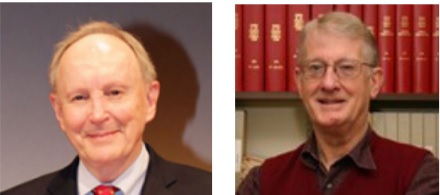 Ken Wynne Dick Walton Ken Wynne Dick Walton
The ONR grant was for studies of the solid-state polymerization reactions of NiX2[P(CH2CH2CN)3]2 (X = Cl, Br, I, -NCS) complexes, a project suggested to us by Dick Walton of Purdue University. The nickel complexes turned out to have a very rich solid-state chemistry: (a) single-crystal-to-single-crystal reactions with unusual reaction-front motion that showed chemo, stereo, and crystallographic specificity [13], and (b) very rich polymorphism, including an example of a disappearing polymorph [14]. During this time I met Dave Curtin and Iain Paul (both at the University of Illinois), who led the premier solid-state reaction group at that time.
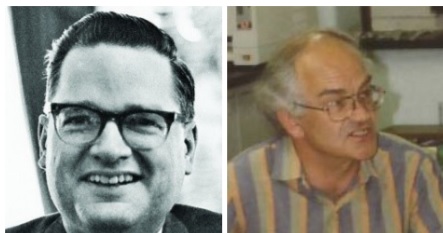 Dave Curtin Iain Paul Dave Curtin Iain Paul
Their papers demonstrated an exciting approach to solid-state reactivity, including the best in crystallography and ground-breaking attention to the study of physical changes in a reacting solid [15]. I soon became an adopted family member of their group, and benefited greatly from some wonderful mentoring. My group carefully examined the physical properties of the reacting nickel complexes, which greatly aided our understanding of these processes. In 1978 I was granted tenure, a very happy event, and, our growing family, expanded with the birth of our son Drew, moved to a bigger house! While a junior person up for tenure, I took on the task of organizing the Vth International Conference on the Chemistry of the Organic Solid State [ICCOSS] at Brandeis [16]. I joked that, if I didn’t get tenure, the Conference would be a great place to look for a new job! Running and organizing the meeting was a hard job, but extremely rewarding, bringing together colleagues who provided new ideas and mentoring, and new acquaintances who would become lifelong friends and collaborators. These included senior folks like Mendel Cohen, Herbert Morawetz, John Thomas, Dave Curtin and Iain Paul, as well as folks closer to my own age: Mike McBride, Gerhard Wegner, Carol Brock, Richard Welberry, Peggy Etter and Joel Bernstein. Early in the meeting planning stages, Iain Paul offered to assist. Despite the geographic distance from Brandeis, he helped in an absolutely immense fashion…I don’t know what I would have done without his support and friendship. As of this writing (early 2020) ICCOSS XXIV was just held the previous summer, organized by my very good friends Mike Ward and Bart Kahr, and XXV will be in Macedonia in 2021, organized by Pance Naumov.
It soon became clear that the work on the nickel cyanophosphine complexes could not be extended beyond the early 1980’s. Regrettably, we were unable to find additional complexes of similar constitution that would exhibit either polymorphism or solid-state reactivity. Thus, inspired by the published work of Herbert Morawetz [17] and our lively snailmail correspondence, as well as the work of the Davydov group in the Soviet Union [18], my research group moved on, to tackle the area of γ-ray induced reactions in solids.
 Herbert Morawetz Herbert Morawetz
Our early work in that area focused on the solid-state polymerization of metal propynoates [19]. Fortunately, around 1987, the Solid State Chemistry program at NSF, then led by my former program director at ONR, Ken Wynne, and later by the highly interactive director and idea-man, Dave Nelson, supported my work, and continued support until my retirement.
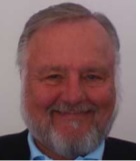 Dave Nelson Dave Nelson
We discovered that the guidelines for predicting and understanding reactivity were rather similar (though not identical) to the criteria of the topochemical postulate developed by Gerhard Schmidt and his group. While a very useful set of guidelines was developed [20-22], the materials were not useful synthetically, as the products were low-molecular weight oligomeric polyacetylenes, and mixtures of isomers. The materials had possible applications as γ-ray dosimeters, but we were unable to develop that owing to stability problems. We thought that, perhaps, substitution at the β-carbon atom of the unsaturated acids might reduce the number of products, and this approach was remarkably successful. Synthesis of various metal complexes with substituted unsaturated acids, including metal crotonates, determination of their crystal structures, and 60Co γ-irradiation, led stereospecifically to dimers, trimers and isotactic polymers, in many cases producing 1 of 4, or (as wonderful as) 1 of 8 possible isomeric products [23-25]! Collaboration with Professor Barry Snider at Brandeis was an indispensable help to sort out the nature of the products using solution NMR, as γ-irradiation of single crystals led to amorphous solids in all cases but one.
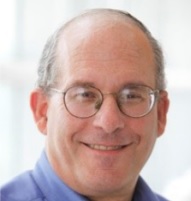 Barry Snider Barry Snider
The rare single-crystal-to-single crystal reaction occurs with Mg(crotonate)2(H2O)6∙2H2O. We studied 4 crystals over many months of irradiation, and this work will be published in 2020.
In 1994 my X-ray lab was upgraded, with NSF and Polaroid support, to two CAD-4 diffractometers. Running a pair of CAD-4 diffractometers, one with Mo and one with Cu radiation, was a real pleasure. What amazing machines these were: I still have one working CAD-4 Turbo in my lab, which I (sadly) think will disappear in the next 12-24 months. The data were truly the best I’d obtained thus far in my career. I had tremendous help, particularly from my good friends Andy Gangloff and Graheme Williams, who supplied tons of good advice about repairs, upgrades, putting machines on the Web in 1994-1995, software, and teaching crystallography. My first tutorials were written for Enraf-Nonius, and whatever good things I’ve done in teaching really came from the seeds planted by Graheme and Andy in the early days of our friendship.
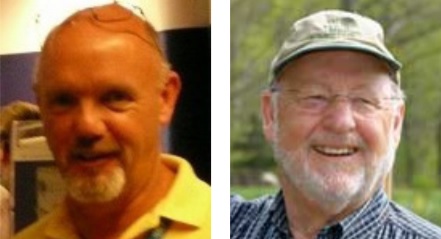 Andy Gangloff Graheme Williams Andy Gangloff Graheme Williams
During the 1995-1996 academic year, I spent a rewarding invited sabbatical at the Max-Planck-Institut für Polymerforchung (MPIP) in Mainz where I worked in Prof. Gerhard Wegner’s laboratory, very closely with his students, and especially enjoyed working with crystallographer Volker Enkelmann. I was amazed that, thanks to Andy Gangloff, Graheme Williams and the folks at Enraf-Nonius, I could run my CAD-4’s from Mainz, a new era for my group.
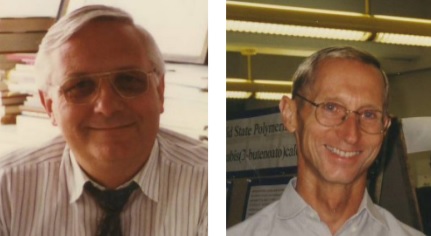 Gerhard Wegner Volker Enkelmann Gerhard Wegner Volker Enkelmann
At that time Gerhard and Volker had just discovered the UV-tail irradiation technique, which they used effectively to turn many [2+2] solid-state cycloadditions into single-crystal-to-single-crystal reactions [26,27]. Regrettably, Prof. Gerd Kaupp of Universität Oldenburg disagreed with their results, and wrote and spoke of their work in a highly vitriolic manner. Later, we collaborated with Gerhard, Volker and student Vera Buchholz, and showed that (a) the crystallographic results were valid and reproducible, and (b) Kaupp’s claims of errors in the analysis of the structural chemistry were quite incorrect [28]. The publication of our paper ended the controversy. I returned to Mainz in 2002, and spoke about the stereospecific solid-state transformations of metal crotonates, including some speculation about the nature of the solid-state radical mechanism. Gerhard smiled, and said to me: “Now you have to do something INTERESTING! Make the 2-deutero- and 3-deutero-crotonates, and show that the reactions, including the proposed hydrogen-transfer aspects of the mechanism, are topochemically-controlled.” Wow. Challenging stuff. It was hard work, but we did it, and the results did indeed show that for a solid-state, radiation-induced, intermolecular radical reaction, hydrogen atom transfer is stereospecific and is not the result of a random process [29- 30].
In 2006, we acquired a Bruker-Nonius Kappa-Apex2 machine thanks to the NSF, and became a late arrival to the CCD world! It became clear in the 2010 decade that we’d no longer be able to carry out radiation-induced reactions in solids, owing to the 5.2-year half-life of our 60Co γ-irradiator, then nearly nine half-lives “gone”. Replacement cost of the source would be in excess of $150,000. We thus returned to studies of thermal transformations in single crystals, akin to our work on the nickel complexes mentioned earlier. However, in the 1970’s we used films to see the changes in unit cell orientation [13], and in 2010, we could generate images (i.e., CCD-“frames”), but they were not aligned! Reconsideration of our own early work, and especially of the work of Jack Gougoutas and Peggy Etter [31,32], a close friend and constant inspiration, even today, showed that it could all be done easily, using the orientation matrices of the “mother” and “daughter” phases of the crystal.
 Peggy Etter Peggy Etter
Further, the process made it quite simple to generate animations of the before-and-after molecular motion [33]. An extension of this work showed that studies of topotactic phase transformations could be used to obtain solutions of the crystal structures of highly disordered materials [34]. A program, TOPO, was written, and made available to readers of the latter two papers who might be interested in carrying out similar analyses [35].
Interests in crystallographic computing and education in crystallography
As I mentioned earlier, in my early career, Mike Bennett and I wrote two revamped versions of Charlie Prewitt’s SFLS-5 refinement program that included rigid-body and (later) hindered-rotor refinement. I continued to use those programs after coming to Brandeis in 1972, at expensive timefor-pay prices at the Smithsonian Astrophysical Observatory (Cambridge, MA) and MIT. After I acquired a Nova 1200 floating point processor, the useful and user-friendly 1976 Syntex XTL programs, followed by the Enraf-Nonius SDP-VAX suite filled my needs until the mid-1980’s, when my head was turned toward the Oxford University refinement program CRYSTALS [36]. David Watkin gave a talk on the program in 1983 at Harvard, and our meeting blossomed into a lasting close friendship.
 David Watkin Richard Cooper David Watkin Richard Cooper
I spent a wonderful four-month sabbatical in Oxford in 1987, and have been a devout CRYSTALS user since that time. There are not an abundance of CRYSTALS users in the US, a continuing surprise to me given the program’s innovation, its clear, logical, plain-English approach, open-source availability, and the grounding of the program as a teaching tool. In 2009, I put together a team to nominate David for his contributions, and he received the Fankuchen Award of the ACA in 2010 [37]. I and my students made various contributions to the program code, as well as to the “Scripts” processor that intelligently feeds commands to CRYSTALS [38]. Most recently David and Richard Cooper asked me to help develop code to analyze an HKLF5 file and produce a twin law from that data, along with an analysis of fit, with regard to the indices of the twin components. That code has been incorporated into CRYSTALS.
I began teaching crystallography formally in a course at Brandeis in 1975, and always tingled as I gave each lecture. My favorite part was the teaching of space groups, inspired by Mike Bennett’s approach to teaching space groups when I was a graduate student at MIT. Later I was also inspired by Menahem Kaftory, who showed me some of his very pretty computer-assisted teaching ideas during a summer stay in my lab. Those thoughts never left my mind, and in 2001, Jerry Jasinski spent a summer in our lab, sponsored by NSF, and together, over the next few years, we developed our Symmetry and Space Groups PowerPoint tutorial.
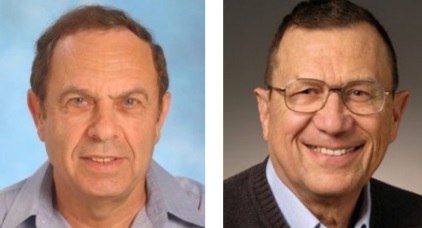 Menahem Kaftory Jerry Jasinski Menahem Kaftory Jerry Jasinski
As we met to bring our ideas in teaching this subject to life, we both felt that “early and often” – teaching the concepts with textual and visual reinforcement, are key to providing a sound basis for students in this subject. The tutorial contains > 200 PowerPoint “slides”, in five modules, arranged by crystal class; a sixth module covers special topics. Each slide has multiple features, with (typically) over five steps to be completed. A “credits” module gives the direct addresses of all links. Space group diagrams appear in International Tables format. The triclinic and monoclinic groups are built from “scratch”, and are derived from the Hermann-Mauguin symbol. An additional section provides practice on many (but not all) of the orthorhombic groups in crystal class 222. Finally, a “Special Topics” section on enantiomorphous space groups features space groups P41 and P43 . In the tutorial, lattice points build iteratively & interactively with keyclick, and the coordinates of points “pop up” as the unit cell is filled. We expected that the elements of guidance, inquiry and occasional humor would make the learning process enjoyable, and indeed, the tutorial has enjoyed thousands of downloads, continuing into the time of writing (January 2020) [39].
In April 2010, an electrical fire, caused by the supreme negligence of a contractor carrying out demolition of a nearby building, led to over $60,000 damage in the X-ray laboratory. Regrettably, things moved very slowly on the repair front (NOT owing to Bruker or the service personnel), and the X-ray lab was closed for over a year, with continuing problems past that time. Eventually we got back on the air, and could continue our studies of topotaxy as mentioned earlier in this narrative. Like many unhappy events that occur, there was a proverbial silver lining to this one. At that time, my friendship and common interests with Victor Young (University of Minnesota) were developing into a collaboration, and we used the time “away” from my usual service and group X-ray work to develop some new ideas about twinning in molecular crystals. We wanted to use Yvon Le Page’s program OBLIQUE to carry out calculations of likely twin relationships and obliquity. It had been available as an online web-tool at NRC-Canada, but when we tried to use it, it was gone, and many attempts to contact Le Page and/or get help from his colleagues, were unsuccessful. The only person willing and able to help was Howard Flack, who rescued me by supplying a copy of the FORTRAN code for CREDUC81, an earlier version of a program used to analyze twinning; Howard had obtained that copy from Le Page.
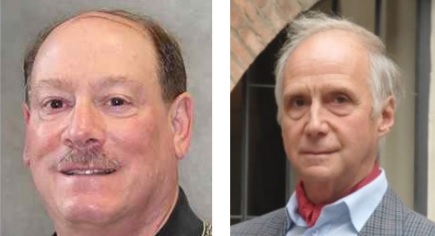 Victor Young Howard Flack Victor Young Howard Flack
Reading that code inspired me to produce the program OMEGA2. OMEGA2, available as a download [40], does everything that OBLIQUE did, plus finding twin laws missed by OBLIQUE, and also provides the twin law matrices for each entry. It is a great tool that Vic and I have found very useful in our current collaboration, which is designed to answer the question of whether there is a relationship between the twin law and a pseudo-symmetry element in a twinned Z’ = 2 structure. Early results look very promising!
Coda
On 17 October 2006, my Ph.D. supervisor and very close friend, Al Cotton, was brutally assaulted. Al battled his injuries for just over four months before passing away on 20 February 2007. As of this writing, his attacker(s) have not been brought to justice. His wonderful friend Debbie Murillo led a team that included her husband, Carlos Murillo (NSF), Larry Falvello (Zaragoza), and myself; we served as co-editors and helped to complete Al’s autobiography [1], which had remained unfinished owing to his untimely passing. I found that to be an uplifting experience, and was very grateful to Debbie, Carlos and Larry for including me. Carlos, Larry and I also wrote a paper on the 50th anniversary of the quadruple bond that also served as a remembrance of the great work that Al and his co-workers carried out [41].
 Larry Falvello Carlos Murillo Larry Falvello Carlos Murillo
Finally, if one is fortunate enough to reach his/her senior years, and carry on in science, we have sad times as we see some of our dearest friends pass on. Here, in addition to Al Cotton, I must mention David Curtin (Illinois), Alan Davison (MIT), Howard Flack (Geneva), Philip Coppens (SUNY-Buffalo), Dan Sandman (UMass – Lowell), Paul O’Brien (University of Manchester), Peggy Etter (University of Minnesota), Bruce Scott (IBM), Alan Sargeson, Glen Robertson, Arthur Birch and David Craig (ANU), Lou Carpino (UMass – Amherst), Keith Prout (Oxford), and, most recently, Joel Bernstein (Ben-Gurion and NYU – Abu Dhabi). Joel’s passing at the beginning of 2019 was particularly sad, as we’d recently met in Boston to celebrate our both being elected as Fellows of the Royal Society of Chemistry, and we had been drawn even closer together while I led his nomination, along with a team of sixteen other scientists(!), for the 2019 ACA Trueblood Award.
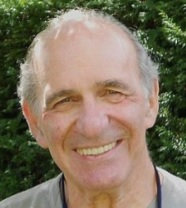 Joel Bernstein Joel Bernstein
During Summer 2019, the scientists at Crystal Pharmatech sponsored a spectacular Symposium in his honor, which is viewable – slides and recorded lectures – on the Web [42]. I was most pleased to give the opening lecture in that Symposium, and to write a paper for the Special Issue of Crystal Growth and Design that honored Joel, and spoke to my close interactions with him and also with Herbert Morawetz [43].
Acknowledgements
My scientific career and its successes would not have been possible without a cadre of superior, dedicated students, whose creativity, hard work, intelligence and good spirits made the greatest contributions. This memoir would not be complete without mentioning them. The Ph.D. students are, in chronological order: Kent Cheng, Harry Mazurek, Susan Gersten, Judy Jauffmann, Brian Sullivan, Christine Stockman, Carlye Booth Case, Graciela Diaz de Delgado, Robert Sandor, Judy Brodkin Sennett, Li Di, Kraig Wheeler, Joval Afalla, Tae Cho, Iman Abdelmoty-Khalil, Michael Vela, Roxana Schlam, Julie Snook, Magali Hickey, Wen Shang, Chengyun Guo, Lin Yang, Chung-Hsin (Josh) Chen and Mark Bezpalko. Three of these folks, Graciela, Magali and Kraig, raised cash and organized an ACA Transactions Symposium in honor of my 70th birthday at the 2012 Boston ACA meeting [44]. My friends from near and far (David Watkin and Kenneth Harris from the UK; Roger Bishop from Australia) attended, and it was truly a HOOT! I should not forget Mark Turnbull, who worked for Mike Rosenblum at Brandeis, and was truly an ‘informal’ Ph.D. student, as he spent much serious time in the X-ray lab. Thesis Master’s students: Michael Moloney and Michael Lee. Undergraduates: Ninon Kafka, Matt Raider, Eric London, Joan Munster, Joan Oppenheimer, Jason Crane, Marshall Corson, Paul Goldberg, Barbara Samaria, Michael Ruth, Warren Kaplan, Jon Melman, Jim Shepherd III, Jon Lorsch, Howard Boey, Karen Grande, Steve Stieglitz, Daniel Kramer, Evan Guggenheim, Sandy Machtiger, Shai Vaday, Jennifer Cotton, Lisa Bennett, Imtiaz Billah, Michael Kahn, Ben Heyman, Melissa Daghighian, Jeremy Heyman, Lawrence Hill, Laura Adduci, Maria Carroll, Aaron Gell, Shai Posner, David Dawson, Onkei Tai, Logan Lorson, Anthony Nguyen, and Ian Batson. I may have missed (with apologies) undergrads and Master’s students who did not write a senior thesis, but many worked hard to make important contributions to the work. With part of my career dedicated to service crystallography, my list of collaborators is extensive, and will not be covered here. However, I do need to mention Wenbin Lin, Oleg Ozerov, Jinquan Yu, Christine Thomas and Casey Wade, my colleagues in inorganic chemistry & Li Deng in organic chemistry at Brandeis: their collaborations definitely made my time More Fun than Fun. Many other friends contributed to my happiness and enthusiasm for science; I mention a few here, not already named in this document: Martin Bennett (ANU), Dave Buckingham (ANU/Otago), Rick Adams (South Carolina), John Bradley (Hull), Pete Wolczanski & Roald Hoffmann (Cornell), Eugene Cheung (Moderna), Erik Vogan (MIT), Marilyn Olmstead (UC-Davis), Ron Parry (Rice), Uwe Bunz (Heidelberg), Dan Frankel & Chuck Campana (Bruker), Terry Haas (Tufts), Brian Straughan (Newcastle), Lee Cronin (Glasgow), Larry Dahl & Ilia Guzei (Wisconsin), Tom Koetzle (Brookhaven/ACA), Ton Spek (Utrecht), Simon Parsons (Edinburgh), Arnie Rheingold (UCSD), Anthony Fernandez (Merrimack) and Andy Zanella (Claremont). I wish I had room, time and space to list the many happy times I’ve had with my other friends in science who are not listed here (apologies, again). Finally, I wish to thank two of my friends at the ACA who helped see this project to completion. First, I thank Virginia Pett, in her role as ACA Historian, for her encouragement, patience and dedication in helping me keep this project on track as I dashed between the conflicting priorities of scientific research, service crystallography, teaching, and some distracting medical issues. And, last but not least, Paul Swepston, who, as RefleXions editor, helped tickle a number of revisions of this document (with great patience) into final form: I look forward to the time when we are safely able to shake hands again!
References
-
Cotton, F. A. My Life in Chemistry : More Fun Than Fun; Falvello, L. R.; Foxman, B. M., Murillo, C. A.; Murillo, D., Assoc. Eds.; Elsevier, Waltham, MA, 2014.
-
Skilling, W. T.; Richardson, R. S. Sun, Moon and Stars : Astronomy for Beginners; McGraw-Hill, New York, 1946.
-
Huttemann, T. J., Jr.; Foxman, B. M.; Sperati, C. R.; Verkade, J. G. Inorg. Chem. 1965, 4, 950-953.
-
Reference 1, page 94.
-
Bennett, M. J.; Cotton, F. A.; Foxman, B. M. Inorg. Chem. 1968, 7, 1563-1569.
-
Bennett, M. J.; Hutcheon, W. L.; Foxman, B. M. Acta Crystallogr., Sect. A 1975, A31, 488-494.
-
Foxman, B. M.; Zanella, A. Comments Inorg. Chem. 2009, 30, 4-6.
-
Foxman, B. M. Chem. Commun. 1972, 515-516; Foxman, B. M. Inorg. Chem. 1978, 17, 1932-1938.
-
Lonsdale, K.; Nave, E.; Stephens, J. F. Phil. Trans. Roy. Soc., Ser. A 1966, 261, 1-31.
-
Buckingham, D. A; Foxman, B. M.; Sargeson, A. M.; Zanella, A. J. Am. Chem. Soc. 1972, 94, 1007-1009; Buckingham, D. A.; Clark, C. R.; Foxman, B. M.; Gainsford, G. J.; Sargeson, A. M.; Wein, M.; Zanella, A. Inorg. Chem. 1982, 21, 1986-1997.
-
Beauchamp, A. L.; Bennett, M. J.; Cotton, F. A. J. Am. Chem. Soc. 1968, 90, 24, 6675-6680.
-
Foxman, B. M.; La Placa, S. J.; Chandrashekhar, G. V.; Foster, L. M.; Weidenborner, J. E. Unpublished manuscript. I hope to post this on my Website, http://www.xray.chem.brandeis.edu in the near future and/or supply copies upon request.
-
Cheng, K.; Foxman, B. M. J. Am. Chem. Soc. 1977, 99, 8102-8103.
-
Foxman, B. M.; Goldberg, P. L.; Mazurek, H. Inorg. Chem. 1981, 20, 4368-4375.
-
A list of Dave and Iain’s solid-state reaction papers appears on my Website: http:// http://people.brandeis.edu/~foxman1/research/database/curtin2.htm
-
Proceedings of the Fifth International Symposium on Organic Solid State Chemistry; Adler, G., Ed.; Part A. Mol. Cryst. Liq. Cryst. 1979, 50 and Part B. Mol. Cryst. Liq. Cryst. 1979, 52.
-
Morawetz, H.; Rubin, I. D. J. Polym. Sci. 1962, 57, 669-686.
-
Davidov, B. E.; Krentsel, B. A.; Kchutareva, G. V. J. Polym. Sci., Part C, 1967, 16, 1365-1374.
-
Booth, C. A.; Foxman, B. M.; Jaufmann, J. D. In Crystallographically Ordered Polymers; Sandman, D. J., Ed.; ACS Symposium Series 337; American Chemical Society: Washington, DC, 1987; pp. 95-105.
-
Brodkin, J. S.; Foxman, B. M. Chem. Commun. 1991, 1073-1075.
-
Di, L.; Foxman, B. M. Chem. Mater. 1992, 4, 258-259.
-
Jaufmann, J. D.; Case, C. B.; Sandor, R. B.; Foxman, B. M. J. Solid State Chem. 2000, 152, 99-104.
-
Vela, M. J.; Buchholz, V.; Enkelmann, V.; Snider, B. B.; Foxman, B. M. Chem. Commun. 2000, 2225-2226.
-
de Delgado, G. C. D.; Wheeler, K. A.; Snider, B. B.; Foxman, B. M. Angew. Chem., Int. Ed. Engl. 1991, 30, 420-422.
-
Cho, T. H.; Chaudhuri, B.; Snider, B. B.; Foxman, B. M. Chem. Commun. 1996, 1337-1338.
-
Enkelmann, V.; Wegner, G.; Novak, K.; Wagener, K. B. J. Am. Chem. Soc. 1993, 115, 10390-10391.
-
Novak, K.; Enkelmann, V.; Wegner, G.; Wagener, K. B. Angew. Chem., Int. Ed. Engl. 1993, 32, 1614-1616.
-
Abdelmoty, I.; Buchholz, V.; Di, L.; Guo, C.; Kowitz, K.; Enkelmann, V.; Wegner, G.; Foxman, B. M. Cryst. Growth Des. 2005, 5, 2210-2217.
-
Hickey, M. B.; Schlam, R. F.; Guo, C.; Cho, T. H.; Snider, B. B.; Foxman, B. M. CrystEngComm 2011, 13, 3146-3155.
-
Shang, W.; Hickey, M. B.; Enkelmann, V.; Snider, B. B.; Foxman, B. M. CrystEngComm 2011, 13, 4339-4350.
-
Gougoutas, J. Z. Isr. J. Chem. 1972, i, 395−407.
-
Etter, M. C. J. Am. Chem. Soc. 1976, 98, 5331−5339.
-
Posner, S. R.; Lorson, L. C.; Gell, A. R.; Foxman, B. M. Cryst. Growth Des. 2015, 15, 3407–3416.
-
Lorson, L. C.; Tai, O.; Foxman, B. M. Cryst. Growth Des. 2018, 18, 409-415.
-
Download from http://www.xray.chem.brandeis.edu .
-
The most up-to-date features are here: http://www.xtl.ox.ac.uk/crystals.1.html .
-
https://history.amercrystalassn.org/h-watkin_videos .
-
Cooper, R. I.; Foxman, B. M.; Yang, L. J. Appl. Cryst. 2004, 37, 669-671.
-
Download from http://people.brandeis.edu/~foxman1/teaching/indexpr.html .
-
Download from http://www.xray.chem.brandeis.edu .
-
Falvello, L. R.; Foxman, B. M.; Murillo, C. A. Inorg. Chem. 2014, 53, 9441−9456.
-
https://www.crystalpharmatech.com/m-jb.html .
-
Heyman, J. B.; Chen, C.-H.; Foxman, B. M. Cryst. Growth Des. 2020, 20, 330-336.
-
Transactions: Transformations and Structural Oddities in Molecular Crystals: In Honor of Bruce M. Foxman, ACA Transactions, 2012, 43.
|


 Isadore Amdur
Isadore Amdur  John Verkade
John Verkade John Corbett
John Corbett  Al Cotton
Al Cotton Leo Becka
Leo Becka Mike Bennett
Mike Bennett Alan Sargeson
Alan Sargeson Glen Robertson
Glen Robertson Arthur Birch
Arthur Birch
 Mike Rosenblum
Mike Rosenblum Sam La Placa
Sam La Placa Ken Wynne Dick Walton
Ken Wynne Dick Walton  Dave Curtin Iain Paul
Dave Curtin Iain Paul Herbert Morawetz
Herbert Morawetz Dave Nelson
Dave Nelson Barry Snider
Barry Snider Andy Gangloff Graheme Williams
Andy Gangloff Graheme Williams Gerhard Wegner Volker Enkelmann
Gerhard Wegner Volker Enkelmann Peggy Etter
Peggy Etter David Watkin Richard Cooper
David Watkin Richard Cooper Menahem Kaftory Jerry Jasinski
Menahem Kaftory Jerry Jasinski Victor Young Howard Flack
Victor Young Howard Flack  Larry Falvello Carlos Murillo
Larry Falvello Carlos Murillo Joel Bernstein
Joel Bernstein